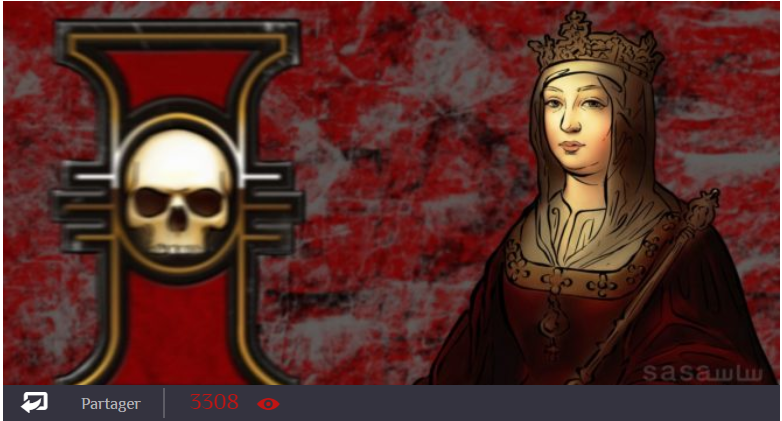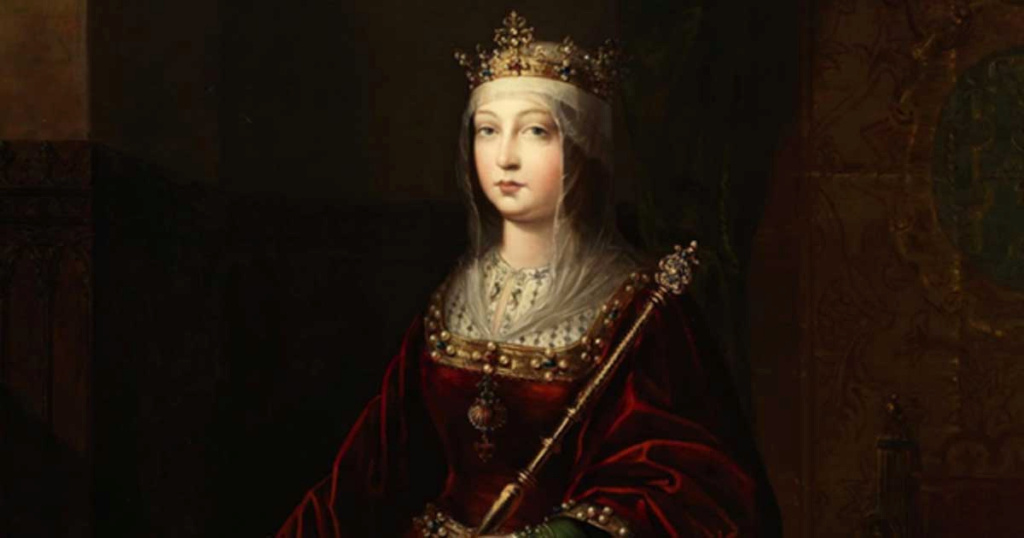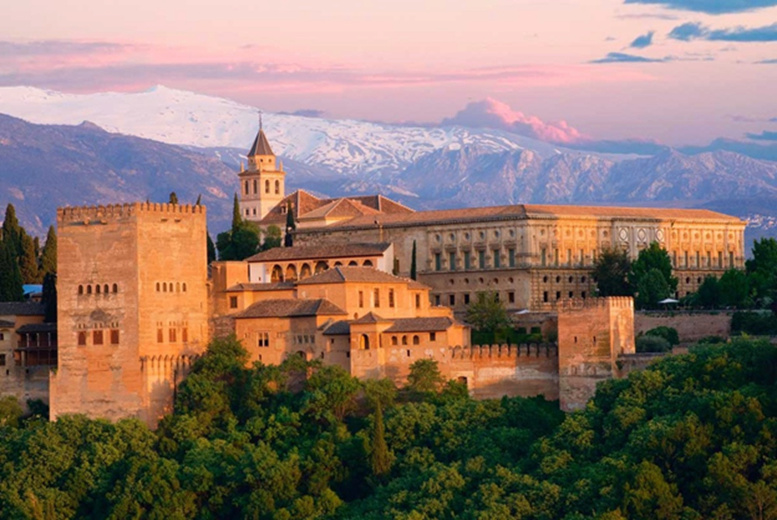"Isabella I"...Queen of Castile, "the violator of the covenant", who established the Inquisition
In 1451, Muhammad X was sitting on the throne of the Kingdom of Granada, when she was born on the opposite side in Castile, the queen who would set her sights on restoring the kingdom and ending the rule of Muslims in Granada, which had then become the last province on which Muslims lived in Spain, after Valencia fell ,Cordoba, Seville, and Murcia were in Christian hands between 1238 and 1260, ending two and a half centuries of Muslim rule in the stretch between the mountains of Nevada and the sea coast from Almeria to Gibraltar.
The square was not calm, as successive wars erupted between Muslims and Christians, who set their sights on the Kingdom of Granada to seize it, and Muhammad X surrendered in its wake and began to pay a royalty to Christians for the maintenance of his kingdom starting in the year 1463 AD, amounting to 12,000 ducats, as Stanley Lynn Paul mentions In the book " The Story of the Arabs in Spain ", the kingdom entered into internal conflicts between the sons of the ruling family - the Red Banu - over rule, and the other side was not better off, as the Christian kingdoms were divided between Castile, Aragon, Navarre, and Leon.
In those years, the Catholic “Princess” Isabella the First was learning and planning to reach the throne of Castile first, and then to what is greater than that, to unite the Christian kingdoms in the Iberian Peninsula and to recover Granada from the hands of the Muslims, to devote herself to achieving other dreams of the prosperity and expansion of her kingdom of Castile. Isabella the First, the Catholic, who was known for her intolerance to Christianity, was a milestone in the history of Spain as well as in the history of the Arabs. The victory she achieved was not easy. It is a life that can be said to be inspiring, had it not been for the extreme fanaticism and breaking the vows with which she confronted her “enemies”, stigmatizing her achievements and making her a subject of historical division until in her.
Isabella I and a long way to the throne
Isabella I grew up in really difficult circumstances; As she did not live the life of princesses, despite being the second daughter of Juan II, King of Castile. At her birth, the king had a son from his first marriage to Maria de Aragon, Enrique, and he was 20 years old. Isabella I was not expected to ascend the throne of the Kingdom of Castile, she has two brothers They were the legal heirs.
A few years later, Juan II departed to enrique Enrique ascending to the throne of the kingdom in 1454 and sending the princess with her mother and younger brother Alfonso away from the palace, to Orivalo, where Isabella I, the mother, became mentally ill due to the death of her husband, King Juan II, and thus was not present in the upbringing of her two children, She remained in this state until her death, in seclusion in Castle Arevalo in 1496.
Isabella I the Catholic - Photo credit: Enchante Origins
Far from the palace, and despite this marginalization, Elizabeth received the education of princesses in Orvalo, where she was raised with her brother Alfonso, along with a mother who suffers from dementia. Isabella I and her brother had been making the way to the throne for years. Her childhood companion, Alfonso, after her brother Enrique IV, was supposed to pass to her younger brother, Enrique IV, and in these complicated circumstances that was the goal she knew.
The first Isabella learned to read, write, ride horses, hunt, dance, sew, and how to behave like a noble, her supervisor being Gonzalo Chacon, the man who guided her, supported her choices, and stood behind her on her long way, and was known for his tendency to negotiate versus confrontation.
At the age of ten, King Enrique IV summoned Isabella I and Alfonso to be under his watch in the Palace of Government, as political instability was ravaging the throne of Enrique IV, and the kingdom faced serious economic difficulties on the one hand, and disputes erupted between the king and the nobles of the kingdom led by Archbishop Alfonso Carrillo of Toledo. another side.
In 1465, the nobles imposed a set of measures that reduced the power of the king, and among the conditions was that Princess Isabella I reside with her brother in Segobia, and there Alfonso the Younger departed, to be Isabella I, a powerful potential heir to the throne, and the other heir was the daughter of King Enrique: Juana.
The throne of Castile looms on the horizon
Only three years later the nobles dictated another condition to Enrique; For Isabella I to be the legitimate successor to the crown of Castile, this is how Isabella I began to approach and prepare to ascend the throne, and as was common in the Middle Ages, her marriage was an opportunity to achieve political goals, so Isabella I began studying the options that a successful political marriage might provide for her, so she refused to marry a king Portugal, wanted by King Enrique, saw her marriage to the heir son of the King of Aragon as an ideal political opportunity, and thus Fernando was chosen.
In absolute secrecy the marriage arrangements began, it was necessary that the two princes obtain special permission from the Pope as they were second cousins, and with the help of Archbishop, Alfonso Carrillo, everything was carried out in absolute secrecy. Fernando left Zaragoza on September 5, 1469 disguised as A servant accompanied only six people, and a few days later the wedding was held in front of a limited number of witnesses.
On a cold December morning, 1474, news reached the palace of Segovia , where the married couple Isabella and Fernando live, that King Enrique IV had died. Showing allegiance to the Queen, but she hadn't actually reached the throne, she still had a few steps ahead of her.
Juana, the daughter of Enrique, declared herself heir to the throne in cooperation with her uncle, King Alfonso of Portugal, who sent an army to defend the throne of Castile in a war that lasted until September 1479 and ended with the treaties of Alcasovas and Mora, and deposited Juana monastery Clares, to ensure that Queen Isabella I would not have Offspring will one day claim the throne, and Isabella I will settle unchallenged on the throne of Castile. After years, the throne of Aragon will pass to her husband, King Fernando, so that the kingdom ruled by the spouses expand, and they devote themselves to the kingdom that troubles them; Granada.
Granada fell and Isabella I broke the covenant
In the book “The Muslims of the Kingdom of Granada after 1492 AD, ” Julio Caro Baroja says, “ The late Juan II reign and the turbulent years of Enrique IV’s reign cannot be considered a period of success with regard to the war against Islam. Those who dated the period of Juan II’s reign regret the inaction of Christians In the year 1449AD, about the war against the Muslims, due to the preoccupation with sectarian wars among them . ”
But the New Testament was different; Even before the interconnection between the kingdoms of Castile and Aragon, King Fernando took advantage of the divisions in the Alhambra between Sultan Abul-Hassan and his brother Al-Zaghal, to change the Islamic cities. The years between 1482 and 1491 AD witnessed the fall of important cities belonging to the Kingdom of Granada, before the kingdom surrendered permanently on November 28 of the same year.
The writer mentions that the terms of the treaty of surrender were - like the treaties for the surrender of previous Islamic cities - in favor of the " defeated " , the jurists and scholars will retain their powers as religious leaders of the Islamic group, and the property will be preserved, but the treaty - as the writer also continues - was violated shortly, as Granada was The last of the Islamic cities, and the Christians were not afraid of revenge from any neighboring city, and another suffering began after a few months that witnessed the breach of covenants and the forcing of Muslims to convert to Christianity; subject to the Inquisition.
Contrary to what happened at the Islamic conquest of the Iberian Peninsula, the tolerance of the different races and religions that lived on the land of the peninsula, those responsible for the Christian “ reconquista ” - the two Catholic monarchs mainly - had no human balance that allowed coexistence between the various groups of society nor the achievement of justice Social.
In the book “ The Moriscos and the Inquisition in Andalusia, ” the author, Abdullah Hammadi, explains how everything that is not Christian faced intolerance and how the “ Christian Reconquista” took accelerated steps towards the abolition of the other party, the Muslim and the Jew . Hadd, even those who accepted the terms of Christianization remained a subject of distrust, as only those who belonged to Christian ancestors were “pure Christians.” As for the recent converts, they did not receive the same treatment in society, and were subject to the threats of the Inquisition.
The two Catholic kings established the Inquisition in 1478 , and its work was concentrated in the Islamic kingdoms that had fallen into the hands of Christians before, and its establishment was mainly to track the Jews who converted to Christianity under duress. Establishment of the Inquisition and persuaded Queen Isabella I to do so.
The court was specialized in cases that it saw as a kind of atheism, and as its name shows, the court was not waiting for cases, it was inspecting itself. In 1492, for example, a decision was issued to expel the Jews from Castile, so that the work of the courts was only the Moors (the Muslims of Granada who remained after its downfall) who were forced to convert to Christianity.
In his introduction to the translation of the book “ The Inquisition and the Moriscos, Minutes of the Court of Cuenca , ” Dr. Jamal Abd al-Rahman mentions that only Muslims were under the authority of the Inquisition, whether the Christianization was of their own will or coercion. It is self-financed, and thus it can be concluded how many of its cases were due to economic reasons.
Marcidis García Arenal, author of the aforementioned book, The Difficulties Facing the Moriscos, recalls that it was a daily confrontation with the ancient Christians, and that all social, cultural and even economic differences were attached to religious difference.
The process of Christianization took on the nature of violence. Muslims had only one of two options; Christianization or torture and imprisonment, thus the betrayal of the Catholic kings to the treaty of surrender was the reason for the emigration of many Muslims from Granada. and confiscation of property.
Bitter motherhood experience
The Queen established a large library of her own, the number of books in it reached 700 volumes; Isabella the First was interested in receiving a classical education for her children, so she established a school in the palace to educate the children of the ruling entourage. .
Isabella I the Catholic gave birth to five children , Isabella I, Juan, Joanna, Catalina and Maria, and motherhood was a bitter experience. It seemed a path towards the unification and expansion of the two kingdoms after Isabella II became the heir to the throne, and with her death Joanna, the third daughter, who had married the son of the King of Austria, became the legitimate successor to the thrones of Castile and Aragon.
Statue of Queen Isabella I the Catholic in Bolivia - Image source Wikimedia
As for the Queen's last suffering, it was what appeared on her legitimate heir; Her daughter Joanna was one of the signs of mental illness. Historians differed as to whether it was a fact or a conspiracy by those around her to seize the throne. She was even known later as " Crazy Joanna ", but what appeared during the Queen's life from Joanna's actions was assuring her that the throne would not be in the hands of Strong reservation of what was accomplished by Isabella I.
On November 26, 1504, the Queen died at the age of 53, the Catholic Queen died in the city of Del Campo, and King Fernando followed her in 1516, and the two kings were buried together in the Royal Chapel of Granada, and it can be said that in the decisions made by the two kings it was difficult to distinguish Between the decisions made by one of them, they combined skill and wisdom, and despite the seeming unity of word between them, Isabella I preserved the rights of her kingdom of Castile and was able to achieve her interests.
Isabella I is one of the most prominent kings of modern Europe; During her reign, the “recovery” of the Iberian Peninsula was completed, and she is credited with discovering the American continent, with the wealth it made available to Spain. She is the “holy queen” for some and the “rapist” for others. The victory that she achieved for her kingdom was not easy. Perhaps history would have remembered her differently if she had not branded her achievements - for her kingdom - as a betrayal of the covenant she had signed herself.
Source: websites





